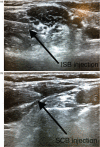Analgesic efficacy of ultrasound-guided interscalene block vs. supraclavicular block for ambulatory arthroscopic rotator cuff repair: A randomised noninferiority study
- PMID: 31361631
- PMCID: PMC6738543
- DOI: 10.1097/EJA.0000000000001065
Analgesic efficacy of ultrasound-guided interscalene block vs. supraclavicular block for ambulatory arthroscopic rotator cuff repair: A randomised noninferiority study
Abstract
Background: Ultrasound-guided interscalene block (ISB) is the reference technique for pain control after ambulatory upper limb surgery, but supraclavicular block (SCB) is an alternative.
Objectives: The aim of this study was to compare the efficacy of SCB vs. ISB in patients undergoing ambulatory arthroscopic rotator cuff repair (ARCR), with the hypothesis of noninferiority of SCB analgesia compared with ISB.
Design: A randomised, single-blind, noninferiority study.
Setting: Hôpital Privé Jean Mermoz, Centre Paul Santy, Lyon, France.
Patients: Ambulatory ARCR patients.
Intervention: Patients were randomly allocated (1 : 1) to receive a single injection SCB or ISB, as well as general anaesthesia. All patients received a postoperative analgesic prescription for home use before leaving hospital (including fast-acting oral morphine sulphate). Patients completed a telephone questionnaire on days 1 and 2 postsurgery.
Main outcome measures: Primary endpoint was oral morphine consumption (mg) during the first 2 days postsurgery. If the difference between mean morphine consumption in the SCB vs. ISB group was less than 30 mg, noninferiority of SCB compared with ISB would be demonstrated. Secondary evaluation criteria included pain scores (numerical rating scale), duration of motor and sensory blockade, and satisfaction with treatment.
Results: The per-protocol cohort included 103 patients (SCB = 52, ISB = 51) (57% men, median age 58 years). Mean morphine consumption in the 48 h postsurgery was 9.4 vs. 14.7 mg in the SCB and ISB groups, respectively (difference -5.3, P < 0.001). The upper limit of the 95% CI was less than 30 mg, demonstrating noninferiority of SCB compared with ISB. No difference was observed between the two groups in terms of pain scores or the duration of motor or sensory blockade. Overall, 98% of patients in the SCB group vs. 90% in the ISB group were satisfied with their treatment.
Conclusion: SCB is as effective as ISB in terms of postoperative analgesia based on oral morphine consumption in patients undergoing ambulatory ARCR.
Trial registration: EudraCT number: 2016-A00747-47.
Figures


References
-
- Data Base PMSI HPJM 2016-2017/Shoulder Surgeons HPJM/GHM 08C40 and 08C48 Shoulder Arthroscopy. Medical Datas Department - Hôpital Privé Jean Mermoz - 3 March 2019.
-
- Uquillas CA, Capogna BM, Rossy WH, et al. Postoperative pain control after arthroscopic rotator cuff repair. J Shoulder Elbow Surg 2016; 25:1204–1213. - PubMed
-
- Fredrickson MJ, Krishnan S, Chen CY. Postoperative analgesia for shoulder surgery: a critical appraisal and review of current techniques. Anaesthesia 2010; 65:608–624. - PubMed
-
- Warrender WJ, Syed UAM, Hammoud S, et al. Pain management after outpatient shoulder arthroscopy: a systematic review of randomized controlled trials. Am J Sports Med 2017; 45:1676–1686. - PubMed
Publication types
MeSH terms
Substances
LinkOut - more resources
Full Text Sources
Medical

